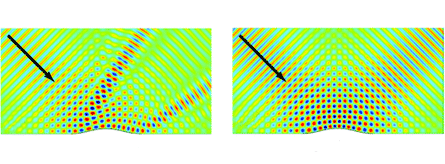Now, an invisibility cloak you can see
Device hides objects in visible wavelengths
The first invisibility cloaks that live up to their whimsical nickname have arrived.

Unlike previous cloaks, which manipulated specially polarized light or microwaves and infrared already invisible to humans, two new approaches bend ordinarily visible light. Disguised by one of these materials, an object could vanish before your eyes.
“If invisibility is the goal, eventually you need to build something that’s detectable by the human eye,” says Majid Gharghi, an applied physicist at the University of California, Berkeley.
The new carpet cloak made by Gharghi’s team team is a sheet of silicon nitride draped over a bump. Usually, light striking this bulge would scatter, revealing the anomaly. But thousands of tiny holes of different sizes etched into the silicon nitride guide the light, hiding the bump and anything concealed beneath it. Light over a wide range of colors behaves as if striking a flat surface instead, the researchers report in the July 13 Nano Letters.
“The experimental demonstration at blue, green and red light looks impressive,” says Steven Cummer, an electrical engineer at Duke University.
The holey pattern in the sponge-like cloak curves light according to the same kind of mathematics that describes how a star’s gravity curves a passing beam. Making such materials, called metamaterials, for visible light has been a long-standing challenge. The holes must be smaller than the wavelength of the light — mere tens of nanometers across for visible light, the shortest wavelengths cloaked to date.
The first prototype isn’t ready to be wrapped up and sent to Hogwarts, though. Its magic works only for light moving in a particular two-dimensional plane. Creating a 3-D silicon nitride bump capable of tricking light coming from any direction would be difficult with the techniques used in this experiment, says Gharghi.
“In this sense, their result is a major step backward,” says Martin Wegener, an applied physicist at the Karlsruhe Institute of Technology in Germany.
Wegener and his colleagues recently developed a carpet cloak that can hide a three-dimensional bump from red light passing through open air. They too perforate a piece of material, opting for plastic that is easier to work with.
The drawback is that holes can be made only so small in the polymer. This cloak can hide an object from red light at 700-nanometer wavelengths but fails at the shorter wavelengths of green and blue light, the researchers report in the June 1 Optics Letters.
Currently, both metal and plastic can hide only microscopic objects.
“With these successful examples, it’s now time to really brainstorm what methods will be scalable and transform these tiny lab toys into something that a broader community can use and enjoy,” says Nicholas Fang, an engineer at MIT who studies metamaterials.
Neither approach is likely to ever disguise a would-be Harry Potter. But supersizing this mastery over light could one day enhance the vision of imaging devices, says Fang, or allow solar panels to suck more energy out of sunlight.







